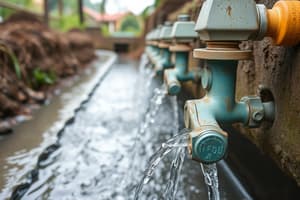Podcast
Questions and Answers
What is meant by 'non-revenue water' in the context of water demand?
What is meant by 'non-revenue water' in the context of water demand?
- Water provided free of charge to low-income households
- Water that is billed but not paid for
- Water consumed for industrial purposes
- Water lost due to leakages and other inefficiencies (correct)
Which factor does NOT influence water demand?
Which factor does NOT influence water demand?
- Availability of water tariffs (correct)
- Water usage habits of people
- Climatological conditions
- Standard of living of the populace
Which service level provides individual household taps?
Which service level provides individual household taps?
- Level I (Point Source)
- Level II (Communal Faucet System)
- Level III (Waterworks System) (correct)
- Level IV (Distribution Network)
For which type of area is Level I water supply most suitable?
For which type of area is Level I water supply most suitable?
What does average day demand represent?
What does average day demand represent?
How many households does a Level I facility typically serve?
How many households does a Level I facility typically serve?
Which service level is characterized by communal faucets serving multiple households?
Which service level is characterized by communal faucets serving multiple households?
What type of demand represents the highest water requirement in a single day over a year?
What type of demand represents the highest water requirement in a single day over a year?
Flashcards
Water Demand
Water Demand
The amount of water needed by a population, considering both present and future needs, and including allowances for non-revenue water (like leaks).
Non-Revenue Water (NRW)
Non-Revenue Water (NRW)
Water lost due to leaks, pipe breaks, or other inefficiencies in the supply system.
Level I Water Service
Level I Water Service
Water service with a protected well or spring, without a distribution system. Users collect water at the source.
Level II Water Service
Level II Water Service
Signup and view all the flashcards
Level III Water Service
Level III Water Service
Signup and view all the flashcards
Maximum Day Demand
Maximum Day Demand
Signup and view all the flashcards
Average Day Demand
Average Day Demand
Signup and view all the flashcards
Minimum Day Demand
Minimum Day Demand
Signup and view all the flashcards
Study Notes
Water Supply
- Water Demand: The quantity of water required by the population to be covered. Sufficient water must be provided for both current and future needs, accounting for non-revenue water (NRW) losses (e.g., leaks).
- Factors Affecting Water Demand: Service type, community size, standard of living, water availability (quantity and quality), water tariffs, and climate.
- Service Levels:
- Level I (Point Source): Protected well or spring with no distribution system. Water is collected directly by users. Generally suitable for rural areas with low affordability and less dense populations (roughly 15 households within 250 meters).
- Level II (Communal Faucet System/Stand Post): Includes source, reservoir, piped distribution network, and communal faucets. One faucet typically serves 4-6 households within a 25-meter radius. Best for rural and urban fringe areas.
- Level III (Waterworks System/Individual House Connections): Includes source, reservoir, piped distribution network, and individual household taps. Suitable for densely populated urban areas where individuals have access to individual connections.
- Demand Variations and Factors:
- Minimum Day Demand: Lowest daily water usage over a year.
- Average Day Demand (ADD): Average daily water requirement.
- Maximum Day Demand: Highest daily water usage over a year.
- Peak Hour Demand: Highest hourly water usage in a day.
- Demand Factors: Ratios for minimum, average, and maximum day demands relative to average daily demand (ADD). -Minimum Day Demand: 0.3 of average day demand -Average Day Demand: 1.0 -Maximum Day Demand: 1.3 of average day demand -Peak hour demand: 2.5 of ADD (>1,000 connections) & 3.0 of ADD (<1,000 connections).
Water Sources
- Water Resources Considerations: After estimating demand, a suitable water source is needed that satisfies both quantity and quality requirements. Consider adequacy, quality, costs, legality and politics.
- Classification of Water Sources:
- Rainwater: Collected rainwater, useful where rainfall is consistent.
- Surface Water: From rivers, streams, lakes, ponds, seas, etc. Usually requires treatment before use.
- Groundwater: Water found underground in aquifers, often cleaner than surface water and more reliable. Can be obtained from springs, wells, and infiltration galleries.
Water Treatment and Wells
-
Production Wells: Wells drilled to extract groundwater. Capacity must match population demands.
-
Steps in Developing Production Wells:
- Evaluate existing well capacity and water quality to utilize them.
- If insufficient capacity or poor quality then consider a new well.
-
Well Hydrology:
- Unsaturated Zone: Soil and rock voids partially filled with water and air.
- Saturated Zone: Voids are completely filled with water (aquifer).
- Water Table: Boundary between the unsaturated and saturated zones.
- Unconfined Aquifer (Water Table Aquifer): Upper limit is the water table.
- Confined/Artesian Aquifer: Between impermeable layers.
- Well Types:
- Shallow Wells: Tap shallow aquifers; yield is unreliable, vulnerable to contamination, shallow depth.
- Deep Wells: Tap deeper aquifers, more stable yield, less susceptible to contamination.
- Artesian Wells: Confined aquifers under pressure, may flow naturally.
-
Well Measurement:
- Static Water Level: Water level when no pumping is occurring.
- Pumping Water Level Water level while pumping.
- Drawdown: Difference between static and pumping water levels.
- Yield: Volume of water extracted per unit time.
Spring Development
- Development Steps: Enlargement of the spring's eye to increase water yield, construction of a springbox.
- Spring box: Protects spring water from contamination.
Studying That Suits You
Use AI to generate personalized quizzes and flashcards to suit your learning preferences.




